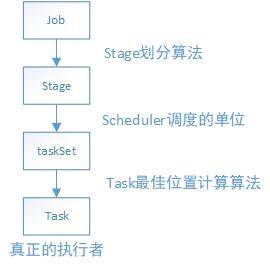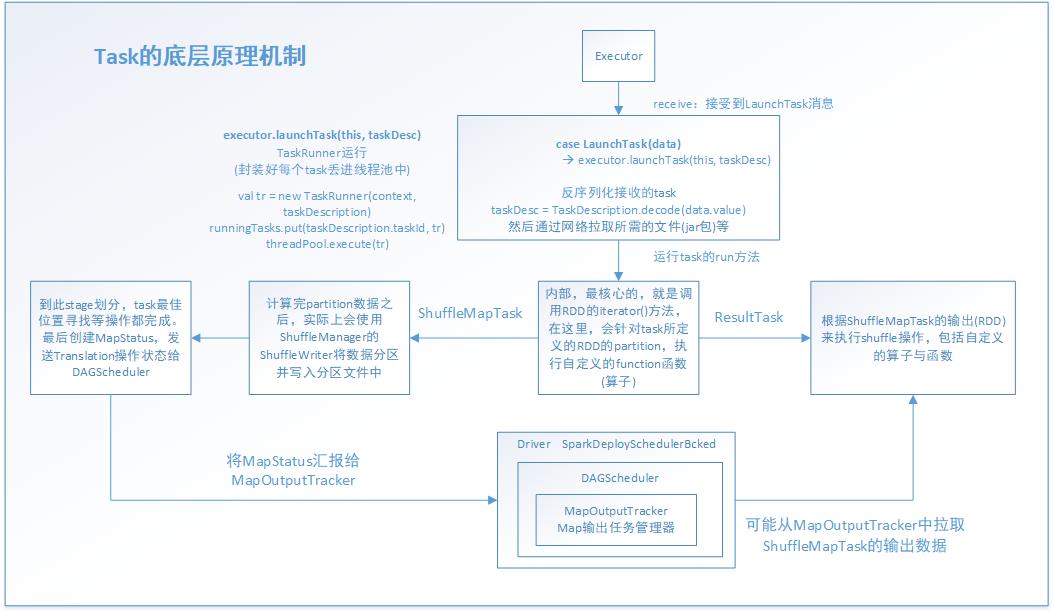Spark之Task原理分析
Posted 那一抹风
tags:
篇首语:本文由小常识网(cha138.com)小编为大家整理,主要介绍了Spark之Task原理分析相关的知识,希望对你有一定的参考价值。
在Spark中,一个应用程序要想被执行,肯定要经过以下的步骤:

从这个路线得知,最终一个job是依赖于分布在集群不同节点中的task,通过并行或者并发的运行来完成真正的工作。由此可见,一个个的分布式的task才是Spark的真正执行者。下面先来张task运行框架整体的对Spark的task运行有个大概的了解。

task运行之前的工作是Driver启动Executor,接着Executor准备好一切运行环境,并向Driver反向注册,最终Driver向Executor发送LunchTask事件消息,从Executor接受到LanchTask那一刻起,task就一发不可收拾了,开始通过java线程来进行以后的工作。当然了,在task正式工作之前,还有一些工作,比如根据stage算法划分好stage,根据task最佳位置计算算法寻找到task的最佳位置(第一期盼都是希望能够在同一个节点的同一个进程中有task所需要的需要,第二才是同一节点的不同进程,第三才是同一机架的不同节点,第四才是不同机架)。这样做的目的是减少网络通信的开销,节省CPU资源,提高系统性能。
其实虽然图片看起来复杂,其实task所做的事情无非以下几点:
1.通过网络拉取运行所需的资源,并反序列化(由于多个task运行在多个Executor中,都是并行运行的,或者并发运行的,一个stage的task,处理的RDD是一样的,这是通过广播变量来完成的)
2.获取shuffleManager,从shuffleManager中获取shuffleWriter(shuffleWriter用于后面的数据处理并把返回的数据结果写入磁盘)
3.调用rdd.iterator(),并传入当前task要处理的partition(针对RDD的某个partition执行自定义的算子或逻辑函数,返回的数据都是通过上面生成的ShuffleWriter,经过HashPartitioner[默认是这个]分区之后写入对应的分区backet,其实就是写入磁盘文件中)
4.封装数据结果为MapStatus ,发送给MapOutputTracker,供ResultTask拉取。(MapStatus里面封装了ShuffleMaptask计算后的数据和存储位置地址等数据信息。其实也就是BlockManager相关信息,BlockManager 是Spark底层的内存,数据,磁盘数据管理的组件)
5.ResultTask拉取ShuffleMapTask的结果数据(经过2/3/4步骤之后的结果)
实现这个过程,task有ShuffleMapTask和ResultTask两个子类task来支撑,前者是用于通过各种map算子和自定义函数转换RDD。后者主要是触发了action操作,把map阶段后的新的RDD拉取过去,再执行我们自定义的函数体,实现各种业务功能。
下面通过源码来分析整个流程:
CoarseGrainedExecutorBackend是executor粗粒度真正的后台处理进程。其中比较重要的是以下函数,主要是用于接受其他工作进程所发送的事件消息,并做对应的响应。
override def receive: PartialFunction[Any, Unit]
executor接受到这个事件消息后,task才真正开始工作。其中的executor.launchTask(this, taskDesc)就是主要的实现函数体
case LaunchTask(data) => if (executor == null) { exitExecutor(1, "Received LaunchTask command but executor was null") } else { val taskDesc = TaskDescription.decode(data.value) logInfo("Got assigned task " + taskDesc.taskId) executor.launchTask(this, taskDesc) }
launchTask方法,主要是new出一个TaskRunner线程,并把它放进java的线程池中运行。通过这里也知道其实Spark的底层是依赖Java和Scala共同实现的。
def launchTask(context: ExecutorBackend, taskDescription: TaskDescription): Unit = { val tr = new TaskRunner(context, taskDescription) runningTasks.put(taskDescription.taskId, tr) threadPool.execute(tr) }
通过看TaskRunner的实现,知道它是继承Runnable的,因此,就知道线程真正的运行体是run()方法。
class TaskRunner( execBackend: ExecutorBackend, private val taskDescription: TaskDescription) extends Runnable 下面是run( )方法的主要部分源码。 override def run(): Unit = { threadId = Thread.currentThread.getId Thread.currentThread.setName(threadName) val threadMXBean = ManagementFactory.getThreadMXBean val taskMemoryManager = new TaskMemoryManager(env.memoryManager, taskId) val deserializeStartTime = System.currentTimeMillis() val deserializeStartCpuTime = if (threadMXBean.isCurrentThreadCpuTimeSupported) { threadMXBean.getCurrentThreadCpuTime } else 0L Thread.currentThread.setContextClassLoader(replClassLoader) val ser = env.closureSerializer.newInstance() logInfo(s"Running $taskName (TID $taskId)") execBackend.statusUpdate(taskId, TaskState.RUNNING, EMPTY_BYTE_BUFFER) var taskStart: Long = 0 var taskStartCpu: Long = 0 startGCTime = computeTotalGcTime() try { // Must be set before updateDependencies() is called, in case fetching dependencies // requires access to properties contained within (e.g. for access control). //对序列化的数据,进行反序列化 Executor.taskDeserializationProps.set(taskDescription.properties) //通过网络通信的方法,把task运行所需要的文件、资源、jar等拉取过来 updateDependencies(taskDescription.addedFiles, taskDescription.addedJars) //最后,通过正式的反序列化操作,将整个task的数据集拉取过来 //这里用ClassLoader的原因是通过指定的上下文资源,进行加载和读取。(当然,反射还有另外的功能:通过反射放射动态加载一个类,创建类的对象) task = ser.deserialize[Task[Any]]( taskDescription.serializedTask, Thread.currentThread.getContextClassLoader) task.localProperties = taskDescription.properties task.setTaskMemoryManager(taskMemoryManager) // If this task has been killed before we deserialized it, let\'s quit now. Otherwise, // continue executing the task. val killReason = reasonIfKilled if (killReason.isDefined) { // Throw an exception rather than returning, because returning within a try{} block // causes a NonLocalReturnControl exception to be thrown. The NonLocalReturnControl // exception will be caught by the catch block, leading to an incorrect ExceptionFailure // for the task. throw new TaskKilledException(killReason.get) } logDebug("Task " + taskId + "\'s epoch is " + task.epoch) env.mapOutputTracker.updateEpoch(task.epoch) // Run the actual task and measure its runtime. //计算task开始的时间 taskStart = System.currentTimeMillis() taskStartCpu = if (threadMXBean.isCurrentThreadCpuTimeSupported) { threadMXBean.getCurrentThreadCpuTime } else 0L var threwException = true /** * value 对于ShuffleMapTask来说,就是MapStatus * 封装了ShuffleMapTask计算的数据,输出的位置 * 后面的ShuffleMapTask会去联系MapOutputTracker来获取一个ShuffleMapTask的输出位置,通过网络网络拉取数据 * ResultTask也是这样的,只不过是查询ShuffleMapTask的结果MapStatus的位置 * 总的来说 MapOutputTracker(Map输出任务管理器),把map和action联系起来了。 */ val value = try { //真正的task的线程执行方法,下面会详细分析 val res = task.run( taskAttemptId = taskId, attemptNumber = taskDescription.attemptNumber, metricsSystem = env.metricsSystem) threwException = false res } finally { val releasedLocks = env.blockManager.releaseAllLocksForTask(taskId) val freedMemory = taskMemoryManager.cleanUpAllAllocatedMemory() if (freedMemory > 0 && !threwException) { val errMsg = s"Managed memory leak detected; size = $freedMemory bytes, TID = $taskId" if (conf.getBoolean("spark.unsafe.exceptionOnMemoryLeak", false)) { throw new SparkException(errMsg) } else { logWarning(errMsg) } } if (releasedLocks.nonEmpty && !threwException) { val errMsg = s"${releasedLocks.size} block locks were not released by TID = $taskId:\\n" + releasedLocks.mkString("[", ", ", "]") if (conf.getBoolean("spark.storage.exceptionOnPinLeak", false)) { throw new SparkException(errMsg) } else { logInfo(errMsg) } } } task.context.fetchFailed.foreach { fetchFailure => // uh-oh. it appears the user code has caught the fetch-failure without throwing any // other exceptions. Its *possible* this is what the user meant to do (though highly // unlikely). So we will log an error and keep going. logError(s"TID ${taskId} completed successfully though internally it encountered " + s"unrecoverable fetch failures! Most likely this means user code is incorrectly " + s"swallowing Spark\'s internal ${classOf[FetchFailedException]}", fetchFailure) } //task结束的时间 val taskFinish = System.currentTimeMillis() val taskFinishCpu = if (threadMXBean.isCurrentThreadCpuTimeSupported) { threadMXBean.getCurrentThreadCpuTime } else 0L // If the task has been killed, let\'s fail it. task.context.killTaskIfInterrupted() //对MapStatus进行各种序列化和封装,后面要发送给MapOutputTracker val resultSer = env.serializer.newInstance() val beforeSerialization = System.currentTimeMillis() val valueBytes = resultSer.serialize(value) val afterSerialization = System.currentTimeMillis() // Deserialization happens in two parts: first, we deserialize a Task object, which // includes the Partition. Second, Task.run() deserializes the RDD and function to be run. /** * 计算出task的一些统计信息,运行时间/反序列化消耗的时间/JAva虚拟机 GC消耗的时间/反序列化消耗的时间 */ task.metrics.setExecutorDeserializeTime( (taskStart - deserializeStartTime) + task.executorDeserializeTime) task.metrics.setExecutorDeserializeCpuTime( (taskStartCpu - deserializeStartCpuTime) + task.executorDeserializeCpuTime) // We need to subtract Task.run()\'s deserialization time to avoid double-counting task.metrics.setExecutorRunTime((taskFinish - taskStart) - task.executorDeserializeTime) task.metrics.setExecutorCpuTime( (taskFinishCpu - taskStartCpu) - task.executorDeserializeCpuTime) task.metrics.setJvmGCTime(computeTotalGcTime() - startGCTime) task.metrics.setResultSerializationTime(afterSerialization - beforeSerialization) // Note: accumulator updates must be collected after TaskMetrics is updated val accumUpdates = task.collectAccumulatorUpdates() // TODO: do not serialize value twice val directResult = new DirectTaskResult(valueBytes, accumUpdates) val serializedDirectResult = ser.serialize(directResult) val resultSize = serializedDirectResult.limit // directSend = sending directly back to the driver //下面是对map结果做序列化和对其做位置等信息的封装,方便网络传输和位置查找。注意,BlockManager 是Spark底层的内存,数据,磁盘数据管理的组件 val serializedResult: ByteBuffer = { if (maxResultSize > 0 && resultSize > maxResultSize) { logWarning(s"Finished $taskName (TID $taskId). Result is larger than maxResultSize " + s"(${Utils.bytesToString(resultSize)} > ${Utils.bytesToString(maxResultSize)}), " + s"dropping it.") ser.serialize(new IndirectTaskResult[Any](TaskResultBlockId(taskId), resultSize)) } else if (resultSize > maxDirectResultSize) { val blockId = TaskResultBlockId(taskId) env.blockManager.putBytes( blockId, new ChunkedByteBuffer(serializedDirectResult.duplicate()), StorageLevel.MEMORY_AND_DISK_SER) logInfo( s"Finished $taskName (TID $taskId). $resultSize bytes result sent via BlockManager)") ser.serialize(new IndirectTaskResult[Any](blockId, resultSize)) } else { logInfo(s"Finished $taskName (TID $taskId). $resultSize bytes result sent to driver") serializedDirectResult } } //调用executor所在的ScoresGrainedExecutorBackend的statusUpdate,更新状态信息 setTaskFinishedAndClearInterruptStatus() execBackend.statusUpdate(taskId, TaskState.FINISHED, serializedResult) } catch { case t: Throwable if hasFetchFailure && !Utils.isFatalError(t) => val reason = task.context.fetchFailed.get.toTaskFailedReason if (!t.isInstanceOf[FetchFailedException]) { // there was a fetch failure in the task, but some user code wrapped that exception // and threw something else. Regardless, we treat it as a fetch failure. val fetchFailedCls = classOf[FetchFailedException].getName logWarning(s"TID ${taskId} encountered a ${fetchFailedCls} and " + s"failed, but the ${fetchFailedCls} was hidden by another " + s"exception. Spark is handling this like a fetch failure and ignoring the " + s"other exception: $t") } setTaskFinishedAndClearInterruptStatus() execBackend.statusUpdate(taskId, TaskState.FAILED, ser.serialize(reason))
executor的task.run,底层主要是task的run方法,很明显看出来,主要工作是创建一个context,把task运行过程中的上下文记录下来。其中关键的是调用抽象方法,runTask。
final def run( taskAttemptId: Long, attemptNumber: Int, metricsSystem: MetricsSystem): T = { SparkEnv.get.blockManager.registerTask(taskAttemptId) //创建 context ,task的执行上下文,里面记录task执行的全局性的数据 //重试次数,task属于哪个stage,task要处理的是哪个rdd,哪个partition等 context = new TaskContextImpl( stageId, partitionId, taskAttemptId, attemptNumber, taskMemoryManager, localProperties, metricsSystem, metrics) TaskContext.setTaskContext(context) taskThread = Thread.currentThread() if (_reasonIfKilled != null) { kill(interruptThread = false, _reasonIfKilled) } new CallerContext( "TASK", SparkEnv.get.conf.get(APP_CALLER_CONTEXT), appId, appAttemptId, jobId, Option(stageId), Option(stageAttemptId), Option(taskAttemptId), Option(attemptNumber)).setCurrentContext() try { //调用抽象方法,runTask runTask(context) } catch { case e: Throwable => // Catch all errors; run task failure callbacks, and rethrow the exception. try { context.markTaskFailed(e) } catch { case t: Throwable => e.addSuppressed(t) } context.markTaskCompleted(Some(e)) throw e } finally { try { // Call the task completion callbacks. If "markTaskCompleted" is called twice, the second // one is no-op. context.markTaskCompleted(None) } finally { try { Utils.tryLogNonFatalError { // Release memory used by this thread for unrolling blocks SparkEnv.get.blockManager.memoryStore.releaseUnrollMemoryForThisTask(MemoryMode.ON_HEAP) SparkEnv.get.blockManager.memoryStore.releaseUnrollMemoryForThisTask( MemoryMode.OFF_HEAP) // Notify any tasks waiting for execution memory to be freed to wake up and try to // acquire memory again. This makes impossible the scenario where a task sleeps forever // because there are no other tasks left to notify it. Since this is safe to do but may // not be strictly necessary, we should revisit whether we can remove this in the // future. val memoryManager = SparkEnv.get.memoryManager memoryManager.synchronized { memoryManager.notifyAll() } } } finally { // Though we unset the ThreadLocal here, the context member variable itself is still // queried directly in the TaskRunner to check for FetchFailedExceptions. TaskContext.unset() } } } }
task是抽象方法,意味着这个类只是模板类,仅仅封装了一些子类通用的属性和方法,依赖于子类实现它们,来确定具体的功能。 前面说过task的有两个子类ShuffleMapTask和ResultTask。有了它们,才能运行定义的算子和逻辑
def runTask(context: TaskContext): T def preferredLocations: Seq[TaskLocation] = Nil // Map output tracker epoch. Will be set by TaskSetManager. var epoch: Long = -1 // Task context, to be initialized in run(). @transient var context: TaskContextImpl = _ // The actual Thread on which the task is running, if any. Initialized in run(). @volatile @transient private var taskThread: Thread = _ // If non-null, this task has been killed and the reason is as specified. This is used in case // context is not yet initialized when kill() is invoked. @volatile @transient private var _reasonIfKilled: String = null protected var _executorDeserializeTime: Long = 0 protected var _executorDeserializeCpuTime: Long = 0 /** * If defined, this task has been killed and this option contains the reason. */ def reasonIfKilled: Option[String] = Option(_reasonIfKilled) /** * Returns the amount of time spent deserializing the RDD and function to be run. */ def executorDeserializeTime: Long = _executorDeserializeTime def executorDeserializeCpuTime: Long = _executorDeserializeCpuTime /** * Collect the latest values of accumulators used in this task. If the task failed, * filter out the accumulators whose values should not be included on failures. */ def collectAccumulatorUpdates(taskFailed: Boolean = false): Seq[AccumulatorV2[_, _]] = { if (context != null) { // Note: internal accumulators representing task metrics always count failed values context.taskMetrics.nonZeroInternalAccums() ++ // zero value external accumulators may still be useful, e.g. SQLMetrics, we should not // filter them out. context.taskMetrics.externalAccums.filter(a => !taskFailed || a.countFailedValues) } else { Seq.empty } }
到此,task整个运行流程已分析一遍,最后,调用下面的函数来更新状态信息
setTaskFinishedAndClearInterruptStatus()
execBackend.statusUpdate(taskId, TaskState.FINISHED, serializedResult)
最后来总结一下,task的运行一开始不是直接调用底层的task的run方法直接处理job-->stage-->taskSet-->task这条路线的task任务的,它是通过分层和分工的思想来完成。task会派生出两个子类ShuffleMapTask和ResultTask分别完成对应的工作,ShuffleMapTask主要是对task所拥有的的RDD的partition做对应的RDD转换工作,ResultTask主要是根据action动作触发,并拉取ShuffleMapTask阶段的结果做进一步的算子和逻辑函数对数据对真正进一步的处理。这两个阶段是通过MapOutputTracker来连接起来的。
以上是关于Spark之Task原理分析的主要内容,如果未能解决你的问题,请参考以下文章